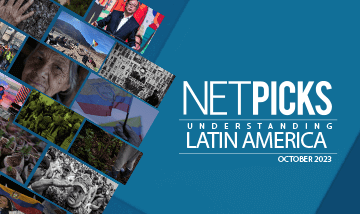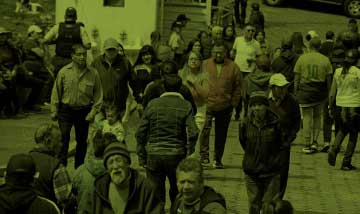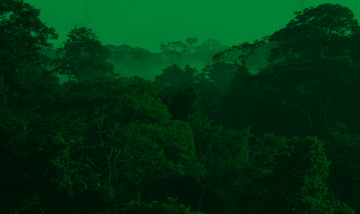Understanding Latin America
This month we bring you articles regarding: the possible impacts of the COVID pandemic on food security in Latin America; from Brazil, on the differences between the political power of the black populations of that country and the United States; from Peru, where indigenous populations in the Amazon region are suffering during the COVID crisis due lack of attention on the part of the central government in Lima; from Venezuela, where the country may lose prize assets to international creditors; and from the coca leaf growing regions; where the poor families that depend on the crop are suffering due to COVID restrictions and political pressure. Finally, we invite you to join us for on JULY 8 for SOUTH DEAL – NORTH DEAL: An on-line dialogue between the Pactoecosocial del Sur and the Green New Deal.
THE FREE MARKET CAN’T PREVENT LATIN AMERICA’S COMING FOOD CRISIS
One of the most threatening aspects of the COVID-19 pandemic is that in the longer term, it threatens to generate a prolonged food crisis in Latin America. Even before the pandemic struck, one-third of Latin America’s population was facing food insecurity, and as economies contract under lockdown and supply chains weaken, the situation is becoming more difficult than ever. The severity of the food situation has also been complicated by a major rise in unemployment caused by the virus. As is widely recognized, hunger is not simply a matter of food scarcity, but also the availability of money to buy it. ECLAC (the UN Economic Commission for Latin America and the Caribbean) has estimated that the Latin American economy could shrink by 5.5 % in 2020: the largest in its history (as of June the IMF the projection is 9.4%), and that such a recession would mean an increase of 11.6 million jobless compared to 2019. Export driven economies are also a factor. In Chile for example, while the Minister of Agriculture has stated the country has enough food to make it through the winter, the country is increasingly reliant on grain imports. Its dynamic export sector has been based on an aggressive modernization of fruit production, meaning that crop varieties crucial for tackling food crises, such as grains, legumes, and tubers, have been given less priority. The situation in Chile shows that export driven agro-food systems in Latin America are inadequate for tackling food crises, and that it is imperative to design and implement national programs for popular nutrition that can guarantee access to food for the most vulnerable groups. How that might be done, and what kind of State would be needed to implement the programs are questions that need urgent answers.
Martín Arboleda, June 6th, 2020
https://www.jacobinmag.com/2020/06/latin-america-covid-19-food
CORONA HITS THE COCAINE SUPPLY CHAIN
The restrictions applied in Colombia, Peru and Bolivia in order to combat the spread of the COVID-19 virus, have had serious consequences for the coca leaf growers in those countries. Two hundred and thirty seven thousand families depend on the leaf for their livelihood, most of them living in marginal areas characterized by limited state presence, inadequate infrastructure, and high rates of poverty. The restrictions have implied greater difficulty in moving the leaf, while production levels have remained the same, resulting prices in Peru and Bolivia falling to a third or even a sixth of previous levels. Whatever their legal or moral status, as a New York university professor explains “Illegal drugs are deeply embedded in local societies and are critical to the survival of many impoverished rural households.” Complicating the situation is the pressure applied by the Trump administration on Colombia, and the new Bolivian government’s politically motivated attacks on the country’s Chapare region: an Evo Morales stronghold and the country’s major coca leaf producing region. The policies and the virus are having a serious effect on the welfare of these mainly poor families, who have few other options for making a living.
Linda Farthing and Thomas Grisaffi , May 27th, 2020
https://nacla.org/news/2020/05/27/corona-hits-cocaine-supply-chain
.
HOW BLACK PEOPLE FACE AND USE VIOLENCE IN THE US AND BRAZIL
A comparison between the situation of black people in Brazil and the United States is complex but revealing. As racially divided, unequal and unjust the United States might be, black people there have been able to organize and fight for justice. In the 20th century, for example, in the 20th century major protests against police violence erupted in Chicago (1919), Harlem (1935), Detroit (1943) and Los Angeles (1943, 1965, 1992). In a perverse way this violence has given black people a certain measure of political power, whereas in Brazil the policy of miscegenation, or racial blending, has led to their being ignored, considered almost non-existent. Black people in Brazil have consequently tended to not define themselves as such, limiting possibilities to organize and counteract the violence perpetrated against them by society in general and by the police in particular. In the last decade, police have killed more than 33,000 civilians, at least 75% of them black men. Things are changing however, more people are defining themselves as black: between 2012 and 2018, the number of Brazilians who identified as such (which in census terms includes brown) was up nearly 30%, while between 2017 and 2018 alone, the number increased by 32.2%. As the author of this article suggests: “Social unrest has proved to be the only language most white Americans understand in the face of racial inequality. Black Brazilians weren’t allowed that language, and it has cost them centuries-worth of systematic killings, hidden in plain sight.”
Manuella Libardi, June 5th, 2020
https://www.opendemocracy.net/en/democraciaabierta/police-brutality-brazil-vs-usa-fight-againt-racism/
.
COVID-19 AND EXTRACTION PRESSURES IN THE PERUVIAN AMAZON
As in other Amazonian countries, in Peru the onslaught of COVID-19 has laid bare the historical racism and inequalities facing indigenous peoples in the Amazon regions. The situation in the Megatoni district is an example of how the combination of these factors has put indigenous communities at risk, even in areas with abundant economic resources. After more than 15 years of high-revenue operations from the area’s Camisea gas fields, Peru’s largest, indigenous people in Megantoni still do not have sufficient public sanitation or potable water, experience recurrent interruptions to the power supply, and suffer a significantly higher level of health problems such as anemia and malnutrition. While local authorities have resources, they are not legally empowered to use them to improve the situation brought about by the COVID pandemic; in the face of the apparent indifference of the central authorities in Lima, actors such as the Catholic Church and native communities themselves have been forced to intervene. The communities have attempted to limit the damage caused by the virus, but are concerned that State pressure to resume extractive activities in the area will increase risks. Indigenous people in Peru have staged a number of protests over the last few decades, but with limited success, and after centuries of discrimination and oppression, respect for their rights is still weak. The authors suggest that perhaps the COVID crisis and its economic impacts could: “help trigger a critical rethinking of the role of the state and roles of Indigenous communities in Amazonian extraction, conservation, and development.”
Ana Watson and Conny Davidsen, June 1st, 2020
https://nacla.org/news/2020/06/01/covid-19-and-extraction-pressures-peruvian-amazon
.
VENEZUELA: VULTURES CIRCLE KEY OIL ASSET
CITGO, an oil refining conglomerate based in Texas and owned by the Venezuelan national company PDVSA (Petróleos de Venezuela SA), is the third largest independent refiner in the United States. The company is consequently extremely important to the Venezuelan economy, but is now under double threat. Having defaulted on a bond payment, the 50.1% of the company’s shares used as collateral could be seized as payment as of July 22nd of this year. At the same time Venezuela is being sued by the Canadian mining company Crystallex, which could be authorized to seize Venezuelan assets such as CITGO, if the US Treasury Department’s Office of Foreign Assets Control (OFAC) gives the go ahead for the company to be liquidated, and its assets sold off. A danger, says the author, is that the company could be valued at much less than its appraised worth of US$8 billion, meaning that Venezuela would lose more than the presently estimated value of its debts. As the author suggests, whoever finally ends up governing Venezuela will need this US-based refining conglomerate in order to rebuild the country. “They must request a new resolution from the United Nations that will protect the assets of their crisis-torn country from predatory creditors.”
Victor Álvarez R., June 6th, 2020
https://lab.org.uk/venezuela-vultures-circle-key-oil-asset/
In new developments (after this article was published) lawyers representing Juan Guaido’s ‘interim government’ (recognized in the U.S.) have presented new arguments to the court in the U.S. State of Delaware in a bid to stop CITGO being liquidated. However, in a recently filtered recording, Guaido’s former Attorney General, José Ignacio Hernández, appears to accept that keeping the company out of the hands of its creditors is going to be very difficult.
http://www.bancaynegocios.com/ex-procurador-hernandez-los-muros-de-defensa-de-citgo-estan-debiles-y-fracturados/
At the same time, in an indirectly related judgment in the United Kingdom, the Maduro government was recently denied access to US $1.8 billion of Venezuelan gold stored in the Bank of England; the UK recognizes Juan Guaidó as Venezuela’s legitimate President. Nicolas Maduro had stated that the money raised by selling $1 billion of the gold would be channeled through the United Nations Development Program in order to help the country to import food and deal with problems related to the COID-19 pandemic.
https://www.nytimes.com/2020/07/02/world/europe/venezuela-gold-uk-nicolas-maduro.html
CAN MULTILATERALISM DELIVER ON AN EQUITABLE POST-PANDEMIC FUTURE? Perspectives from Bolivia
The Sustainable Development Goals (SDGs) were adopted in 2015 by all member states of the United Nations as a call to end poverty, protect the planet, and ensure that all people enjoy peace and prosperity by 2030. Now, in 2020, with COVID-19 wreaking havoc on the global economy, world leaders affirm that we are all in the same boat and that it is time to work together, while national responses largely focus on finding ways to support their citizens with economic packages and health services. The unasked question is: where does this leave people on the margins of society? The Rosa-Luxemburg-Stiftung’s Tetet Nera-Lauron spoke with Alejandro Barrios Noya, a civil society expert from Bolivia. Alejandro is Director of the Instituto Politecnico Tomas Katari, an organization focused on interculturality, environmental sustainability, and food sovereignty as means to achieve Buen Vivir (“living well”)
https://www.rosalux.de/en/news/id/42513/can-multilateralism-deliver-on-an-equitable-post-pandemic-future






